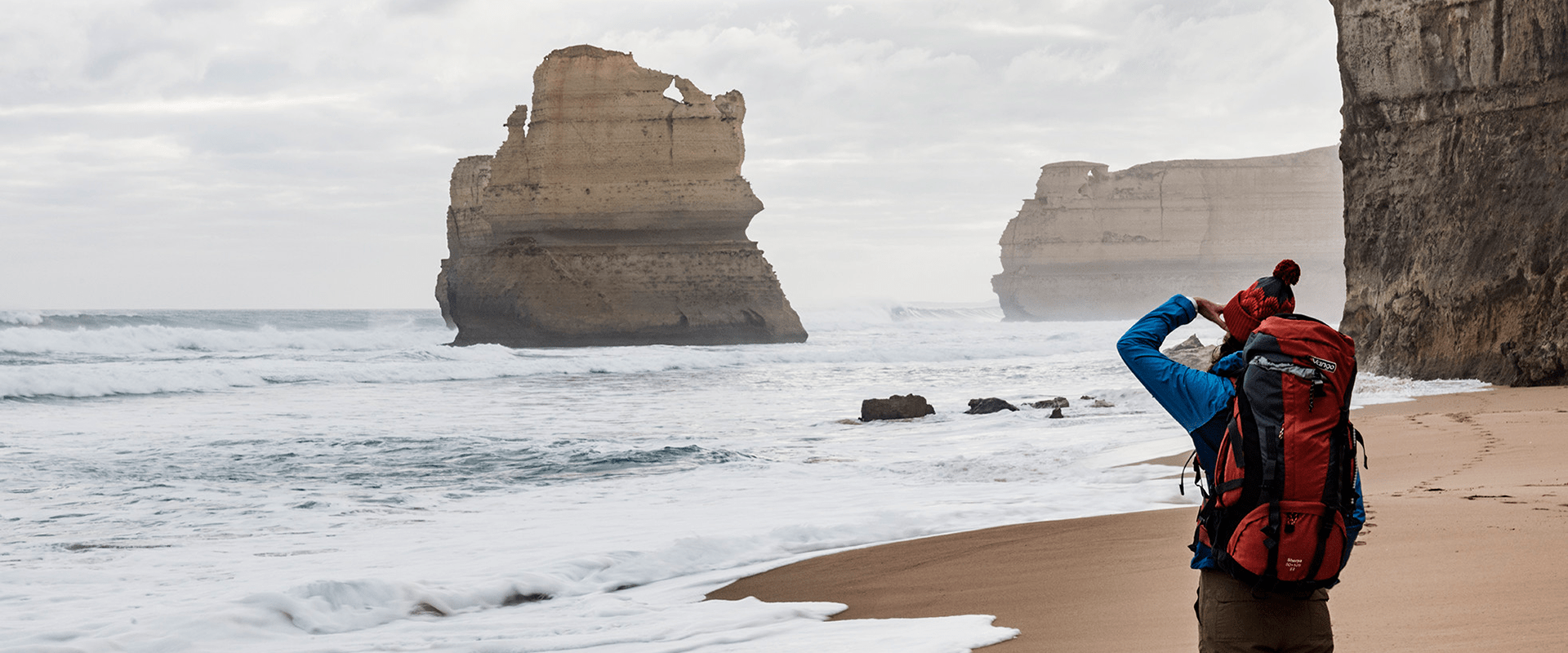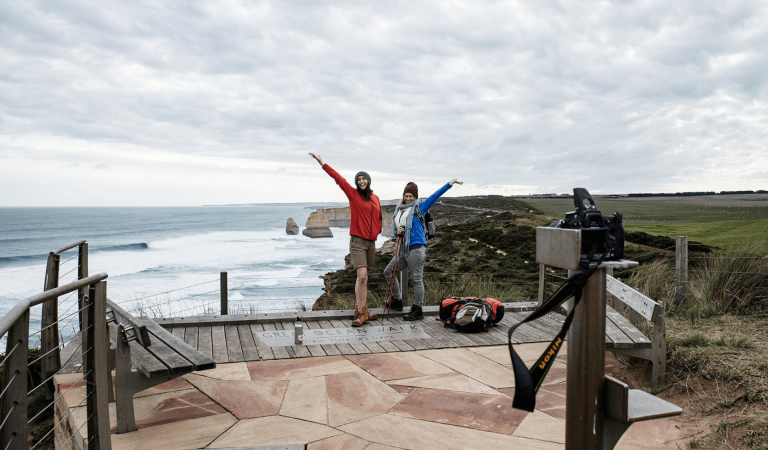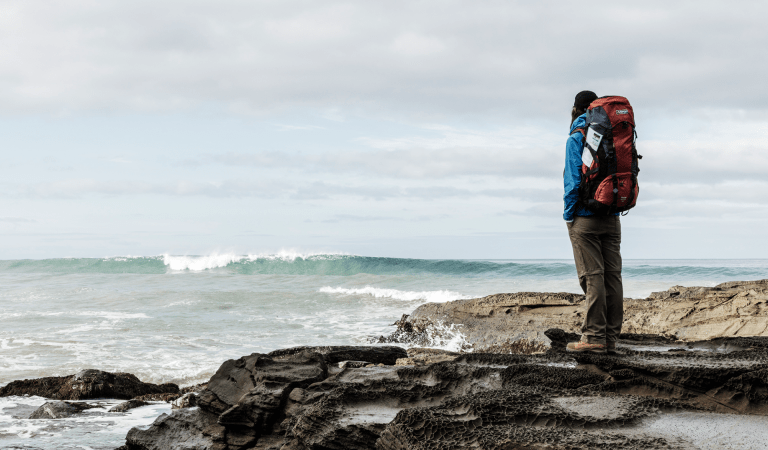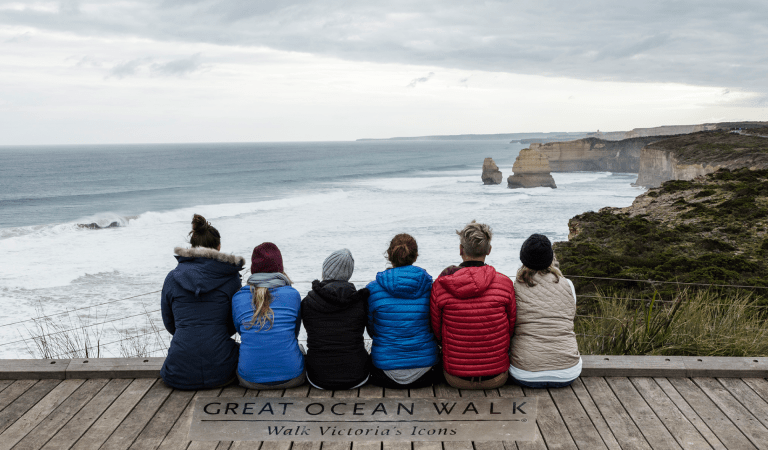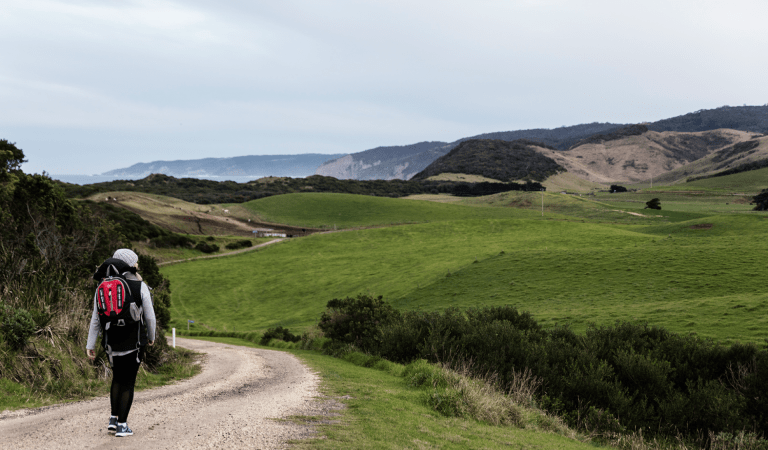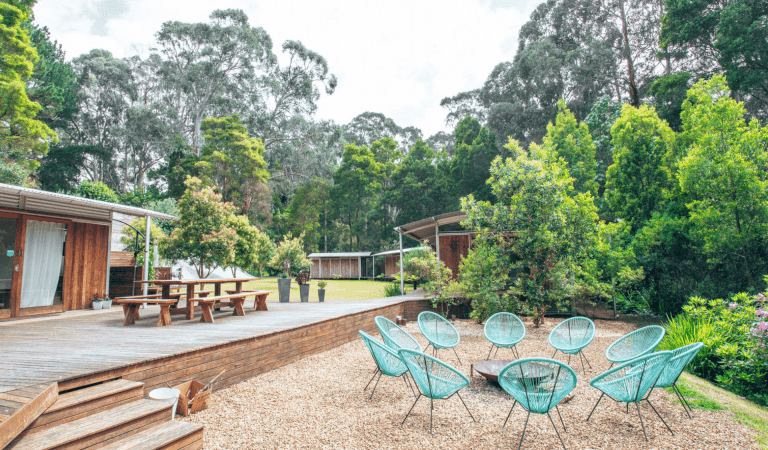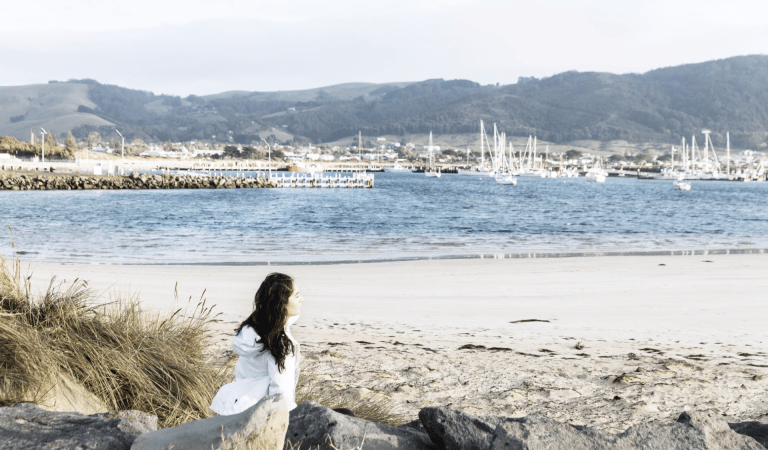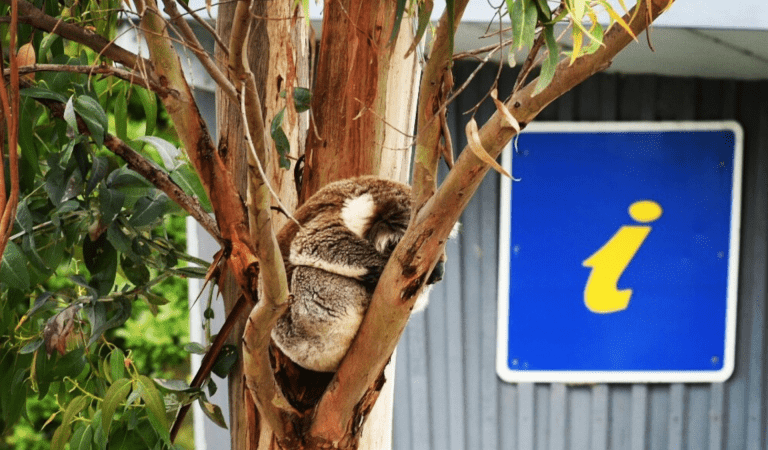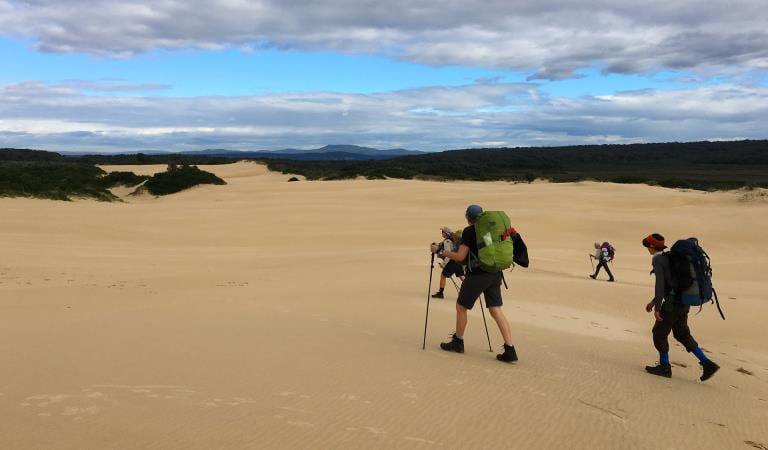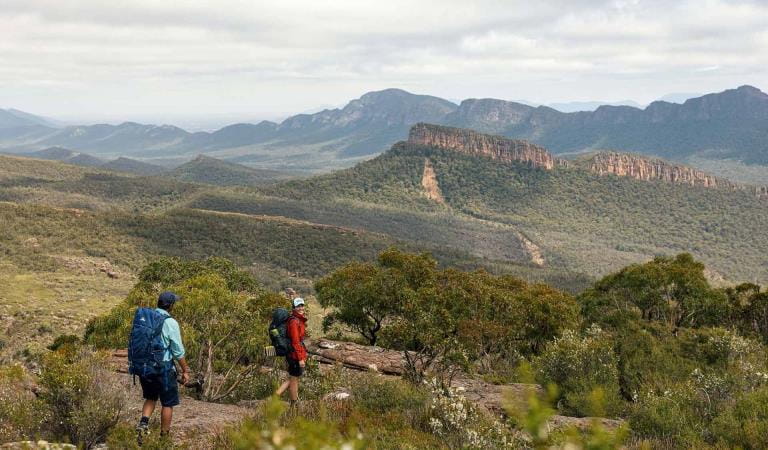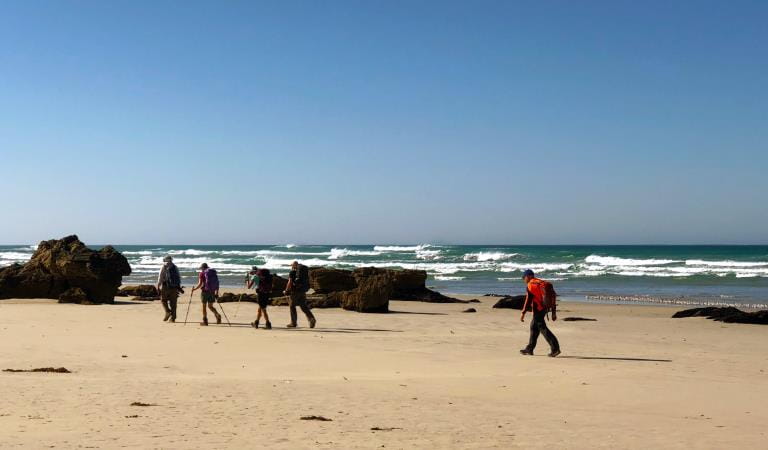If you'd like to hike for several days, there's a variety of itineraries on the Great Ocean Walk to suit your needs. Plan your hiking adventure according to how much time you have, and how frequently you would like to stop and camp overnight.
4 night, 5 day walks
Apollo Bay to Johanna Beach
Coast, tall forest and heathland walk
![]() Start: Apollo Bay Visitor Information Centre
Start: Apollo Bay Visitor Information Centre
Day 1: Apollo Bay to Elliot Ridge – 10km, walk grade: medium
![]() Elliot Ridge Great Ocean Walk Campsite
Elliot Ridge Great Ocean Walk Campsite
Day 2: Elliot Ridge to Blanket Bay – 12km, walk grade: easy
![]() Blanket Bay Great Ocean Walk Campsite
Blanket Bay Great Ocean Walk Campsite
Day 3: Blanket Bay to Cape Otway – 11km, walk grade: easy/medium
![]() Cape Otway Great Ocean Walk Campsite
Cape Otway Great Ocean Walk Campsite
Day 4: Cape Otway to Aire River – 10km, walk grade: medium
![]() Aire River Great Ocean Walk Campsite
Aire River Great Ocean Walk Campsite
Day 5: Aire River to Johanna Beach – 14km, walk grade: medium
OPTIONAL ![]() Johanna Beach Great Ocean Walk Campsite
Johanna Beach Great Ocean Walk Campsite
![]() End: Johanna Beach car park
End: Johanna Beach car park
Cape Otway to Twelve Apostles
Coast and heathland walk. Spectacular views. Takes you to the end of the walk within sight of the Twelve Apostles.
![]() Start: Cape Otway Lightstation car park
Start: Cape Otway Lightstation car park
Day 1: Cape Otway to Aire River– 10 km, walk grade: medium
![]() Aire River Great Ocean Walk Campsite
Aire River Great Ocean Walk Campsite
Day 2: Aire River to Johanna Beach – 14km, walk grade: medium
![]() Johanna Beach Great Ocean Walk Campsite
Johanna Beach Great Ocean Walk Campsite
Day 3: Johanna Beach to Ryans Den – 14km, walk grade: medium/hard
![]() Ryans Den Great Ocean Walk Campsite
Ryans Den Great Ocean Walk Campsite
Day 4: Ryans Den to Devils Kitchen – 13km, walk grade: medium/hard
![]() Devils Kitchen Great Ocean Walk Campsite
Devils Kitchen Great Ocean Walk Campsite
Day 5: Devils Kitchen to Twelve Apostles – 16km, walk grade: medium/hard
![]() End: Twelve Apostles
End: Twelve Apostles
5 night, 6 day walks
Blanket Bay to Twelve Apostles
Great views. Ends Twelve Apostles.
![]() Start: Blanket Bay car park
Start: Blanket Bay car park
Day 1: Blanket Bay to Cape Otway – 11km, walk grade: easy/medium
![]() Cape Otway Great Ocean Walk Campsite
Cape Otway Great Ocean Walk Campsite
Day 2: Cape Otway to Aire River – 10km, walk grade: medium
![]() Aire River Great Ocean Walk Campsite
Aire River Great Ocean Walk Campsite
Day 3: Aire River to Johanna Beach – 14km, walk grade: medium
![]() Johanna Beach Great Ocean Walk Campsite
Johanna Beach Great Ocean Walk Campsite
Day 4: Johanna Beach to Ryans Den – 14km, walk grade: medium/hard
![]() Ryans Den Great Ocean Walk Campsite
Ryans Den Great Ocean Walk Campsite
Day 5: Ryans Den to Devils Kitchen – 13km, walk grade: medium/hard
![]() Devils Kitchen Great Ocean Walk Campsite
Devils Kitchen Great Ocean Walk Campsite
Day 6: Devils Kitchen to Twelve Apostles – 16km, walk grade: medium/hard
![]() End: Twelve Apostles
End: Twelve Apostles
Push the timeline: The whole Great Ocean walk in six days
![]() Start: Apollo Bay Visitor Information Centre
Start: Apollo Bay Visitor Information Centre
Day 1: Apollo Bay to Elliot Ridge – 10km, walk grade: medium
![]() Elliot Ridge Great Ocean Walk Campsite
Elliot Ridge Great Ocean Walk Campsite
Day 2: Elliot Ridge to Cape Otway – 24.7km, walk grade: easy/medium
![]() Cape Otway Great Ocean Walk Campsite
Cape Otway Great Ocean Walk Campsite
Day 3: Cape Otway to Johanna Beach – 24.7km, walk grade: medium
![]() Johanna Beach Great Ocean Walk Campsite
Johanna Beach Great Ocean Walk Campsite
Day 4: Johanna Beach to Ryans Den – 14km, walk grade: medium/hard
![]() Ryans Den Great Ocean Walk Campsite
Ryans Den Great Ocean Walk Campsite
Day 5: Ryans Den to Devils Kitchen – 13km, walk grade: medium/hard
![]() Devils Kitchen Great Ocean Walk Campsite
Devils Kitchen Great Ocean Walk Campsite
Day 6: Devils Kitchen to Twelve Apostles – 16km, walk grade: medium/hard
![]() End: Twelve Apostles
End: Twelve Apostles
6 night, 7 day walks
Great views. Ends Twelve Apostles.
![]() Start: Shelley Beach car park
Start: Shelley Beach car park
Day 1: Shelley Beach to Blanket Bay – 13.5 kms
![]() Blanket Bay Great Ocean Walk Campsite
Blanket Bay Great Ocean Walk Campsite
Day 2: Blanket Bay to Cape Otway – 11km, walk grade: easy/medium
![]() Cape Otway Great Ocean Walk Campsite
Cape Otway Great Ocean Walk Campsite
Day 3: Cape Otway to Aire River – 10km, walk grade: medium
![]() Aire River Great Ocean Walk Campsite
Aire River Great Ocean Walk Campsite
Day 4: Aire River to Johanna Beach – 14km, walk grade: medium
![]() Johanna Beach Great Ocean Walk Campsite
Johanna Beach Great Ocean Walk Campsite
Day 5: Johanna Beach to Ryans Den – 14km, walk grade: medium/hard
![]() Ryans Den Great Ocean Walk Campsite
Ryans Den Great Ocean Walk Campsite
Day 6: Ryans Den to Devils Kitchen – 13km, walk grade: medium/hard
![]() Devils Kitchen Great Ocean Walk Campsite
Devils Kitchen Great Ocean Walk Campsite
Day 7: Devils Kitchen to Twelve Apostles – 16km, walk grade: medium/hard
![]() End: Twelve Apostles
End: Twelve Apostles
Push the timeline Option 1: The whole Great Ocean walk in seven days
![]() Start: Apollo Bay Visitor Information Centre
Start: Apollo Bay Visitor Information Centre
Day 1: Apollo Bay to Elliot Ridge – 10km, walk grade: medium
![]() Elliot Ridge Great Ocean Walk Campsite
Elliot Ridge Great Ocean Walk Campsite
Day 2: Elliot Ridge to Cape Otway – 24.7km, walk grade: easy/medium
![]() Cape Otway Great Ocean Walk Campsite
Cape Otway Great Ocean Walk Campsite
Day 3: Cape Otway to Aire River – 10km, walk grade: medium
![]() Aire River Great Ocean Walk Campsite
Aire River Great Ocean Walk Campsite
Day 4: Aire River to Johanna Beach –14km, walk grade: medium
![]() Johanna Beach Great Ocean Walk Campsite
Johanna Beach Great Ocean Walk Campsite
Day 5: Johanna Beach to Ryans Den –14km, walk grade: medium/hard
![]() Ryans Den Great Ocean Walk Campsite
Ryans Den Great Ocean Walk Campsite
Day 6: Ryans Den to Devil’s Kitchen – 13km, walk grade: medium/hard
![]() Devils Kitchen Great Ocean Walk Campsite
Devils Kitchen Great Ocean Walk Campsite
Day 7: Devil’s Kitchen to Twelve Apostles – 16km, walk grade: medium/hard
![]() End: Twelve Apostles
End: Twelve Apostles
Push the timeline Option 2: The whole Great Ocean walk in seven days
![]() Start: Apollo Bay Visitor Information Centre
Start: Apollo Bay Visitor Information Centre
Day 1: Apollo Bay to Elliot Ridge – 10km, walk grade: medium
![]() Elliot Ridge Great Ocean Walk Campsite
Elliot Ridge Great Ocean Walk Campsite
Day 2: Elliot Ridge to Blanket Bay – 12km, walk grade: easy
![]() Blanket Bay Great Ocean Walk Campsite
Blanket Bay Great Ocean Walk Campsite
Day 3: Blanket Bay to Cape Otway – 11km, walk grade: easy/medium
![]() Cape Otway Great Ocean Walk Campsite
Cape Otway Great Ocean Walk Campsite
Day 4: Cape Otway to Johanna Beach –25.1km, walk grade: medium
![]() Johanna Beach Great Ocean Walk Campsite
Johanna Beach Great Ocean Walk Campsite
Day 5: Johanna Beach to Ryans Den –14km, walk grade: medium/hard
![]() Ryans Den Great Ocean Walk Campsite
Ryans Den Great Ocean Walk Campsite
Day 6: Ryans Den to Devil’s Kitchen – 13km, walk grade: medium/hard
![]() Devils Kitchen Great Ocean Walk Campsite
Devils Kitchen Great Ocean Walk Campsite
Day 7: Devil’s Kitchen to Twelve Apostles – 16km, walk grade: medium/hard
![]() End: Twelve Apostles
End: Twelve Apostles
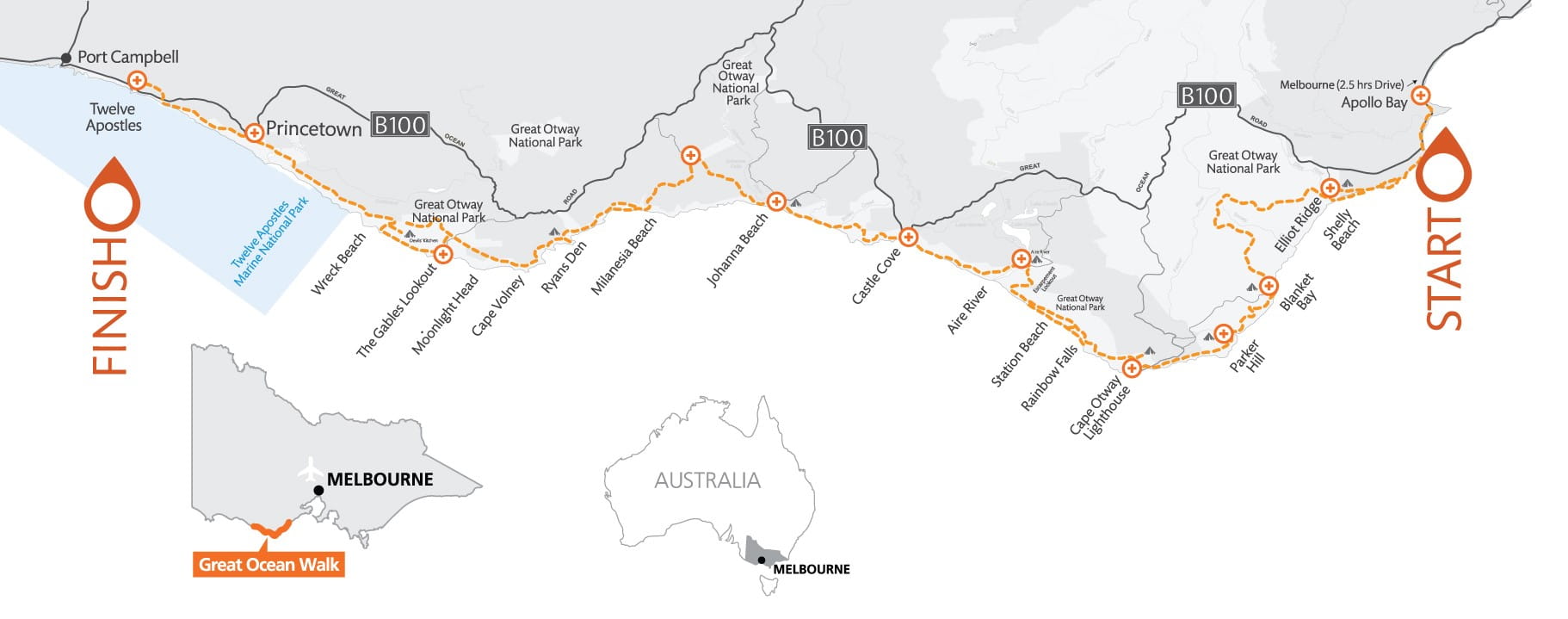
More Great Ocean Walk Experiences
Licensed tour operators
Hike for 1–3 nights
Hike the whole 8 days
Short and Day Walks
How to get there
4-6 night hikes
No designated long-term parking exists for the Great Ocean Walk. It is strongly recommended that hikers use the shuttle services available.
We suggest the following shuttles:
- Walk 91: 0439 893 950
- Ride With Us: 0438 407 777
Alternatively, use public transport. The V/Line bus stops at the Twelve Apostles Carpark, Princetown and Apollo Bay.
When you're there
Explore the region
Off-walk accommodation
Towns and Villages
Eat and Drink
Visitor Information Centres
Need to know
4-6 night hikes
Plan and Prepare
Walkers must move in an east-west direction. The walk was designed and built to be walked in an east-west direction. This will maximise views and generally provides the best gradient to reduce impacts from walkers and congestion of the walk and its facilities.
If you have not undertaken a long-distance walk before, or for a reasonable period of time, it is recommended you undertake some walk training. You will be walking all day, for up to 8 days. There are steep staircases and track sections that go up and down again. Sections of the track can be wet, muddy and slippery. Prepare well to enjoy yourself and get the most from your experience.
A Trip Intention Form is advised for any hikers undertaking walking/hiking overnight
Beach Walking and High Tides
Planning ahead using tide times may save yourself a lot of inconvenience, disappointment and delay during your walk. Many beaches are exposed to high tides, large waves and hidden dangers like ocean currents, rips and reefs.
In some sections of the Great Ocean Walk, alternate beach walking sections are available. Beach access points are marked on the Great Ocean Walk Map and on the walk. Emergency markers state your ‘on and off’ access points and yellow flags mark track arrival and departure points from the beach.
The Great Ocean Walk in-land routes offer shelter from strong sun, bad weather, high tides and waves. It is vital that you consider tides, ocean swell and weather before taking an alternate route. Conditions may change quickly. You should only attempt to walk along the coastline during low tide and calm sea conditions.
The Great Ocean Walk route is clearly marked with signs and has inland options in all areas except Storm Point, West of Bald Hill, Johanna Beach and Milanesia Beach first section. Beach walking is required in the Milanesia (300m) and Johanna (2km) sections of the walk. These beaches and generally passable under normal tide and calm weather conditions. Only proceed with these sections when it is safe to do so.
Wreck Beach (at Moonlight Head) should only be walked at low tide. Walking under the cliff line can become dangerous or impassable at high tide or with large ocean swell. Ensure you are aware of Port Campbell tide times prior to attempting this section of the walk.
Refer to Port Campbell tide times (subtract 4 minutes from Portland tide times) for west of Moonlight Head to the Twelve Apostles, including Wreck Beach.
Refer to Apollo Bay tide times (subtract 28 minutes from Port Phillip Heads times) for east of Moonlight Head.
River crossings
No pedestrian bridge exists for Elliot, Parker Inlet, Johanna and Milanesia River crossings. Heavy rain, rough seas and high tides may make crossings at Elliot, Parker, Johanna and Milanesia Rivers challenging or impossible. Hikers may need to wade across rivers after high rainfall.
It is your responsibility to carefully assess depth and flow before you cross. Be prepared to wait until you consider it safe to cross.
Frequently Asked Questions
-
Can I have a campfire?
Campfires are NOT permitted within Great Ocean Walk hike-in campsites at any time.
The nearby car-based Blanket Bay Campground and Aire River West Campground permit campfires. Campfires are only permitted in the designated fireplaces and campers must bring their own firewood from outside the national park.
It is prohibited to light a campfire on a declared Total Fire Ban day in the South West Weather District, inside or outside tents, shelters or toilets. A portable gas stove is permitted to use for the sole purpose of meal preparation, providing it is in a stable position, in a 3m area cleared of flammable material. You have at least 10L of water immediately available and an adult must be present.
-
What if I cannot complete the walk?
To assist park staff to locate and contact people on the walk when emergencies occur and to ensure hiker safety, it is important that you inform Parks Victoria if you do not complete any section of your registered hike.
For your safety, and your role and responsibility in supporting efficient search and rescue, we recommend you register your trip intentions to aid emergency support should the need arise.
A Trip Intention Form is advised for any hikers undertaking walking/hiking overnight.
-
Where can I park my car?
No designated long-term parking exists for the Great Ocean Walk. It is strongly recommended that hikers use the shuttle services available.
There are unsecured public car parks on the foreshore between Apollo Bay and Marengo. No designated long-term parking exists in this area. Unsecured public parking exists in the Great Otway National Park at day-visitor car parks and camping areas.
Parking may be available at Princetown Recreation Reserve for hikers completing the 'end' of the walk. You should confirm with the Princetown Recreation Reserve caretaker (call 0457 198 662) BEFORE parking there. This is relatively secure parking and walkers can drop their packs off at their cars here before continuing the final 5km to end at the Twelve Apostles.
Great Otway and Port Campbell National Park carparks are open to the public at all times. Please note:
- The Twelve Apostles carpark is not patrolled after hours.
- Hikers leave their vehicles in these areas at their own risk.
- Please remember to remove valuables and lock your vehicle.
- It is NOT recommended that visitors use Gibson Steps carpark for overnight parking. (very small, no facilities)
Your car safety remains your responsibility. Be sure to advise police if you intend to leave a vehicle for any length of time beyond one day.
-
Is there drinking water available along the walk?
There are rainwater tanks at the Great Ocean Walk hike-in campgrounds, which collect untreated rainfall water. Due to the remote nature of the campsites, Parks Victoria cannot guarantee rainwater availability at each campsite.
It is anticipated that Great Ocean Walk campsite rain water tank levels are currently at adequate levels for use by hikers. If they drop below serviceable volumes, our Ranger team will provide advice in the change of conditions section of this page.
Hikers are responsible for their own water requirements. Tank-rainwater, when present, can be treated in several ways such as filtering and boiling or adding sterilisation tablets. Hikers should carry extra water in warm weather.
There are a number of licensed tour operators who provide options to have water dropped off or delivered ahead of your hike.
-
Can I purchase food along the way?
It is recommended you carry enough food for the walk as options for purchasing food are very limited. You may be able to purchase food from the following locations:
- The historic Cape Otway Lightstation precinct café serves light meals and refreshments during business hours. Entry fees apply.
- The Lightstation entry station sells cold drinks and snacks to visitors choosing not to enter the historic area.
- Apollo Bay has supermarkets for comprehensive shopping needs and nearby villages are located at Lavers Hill and Princetown and Bimbi Park on Cape Otway.
Parks Victoria’s licensed tour operators can provide a food and water drop-off service
-
What should I bring?
Whether you are planning a multi-day hike or an afternoon walk, it is important to plan in advance. Coastal weather can change quickly and be unpredictable in all seasons. Be prepared for strong winds, heavy rain; as well as hot or cold weather throughout the year.
- Protective clothing such as a jumper, weatherproof jacket, hat and sunscreen.
- Sturdy footwear with a good tread.
- First Aid Kit — for blisters, sunburn, stings and bites (especially if you have extreme reactions/allergies).
- A large waterproof bag – may be useful for keeping gear dry inside your pack when crossing rivers.
- A portable radio (not mobile phone/internet access) for immediate access to Emergency broadcasting and updates (e.g. fire and storm warnings and updates) including ABC Local Radio.
- Food and Water — Carry food, water, water treatment methods, and equipment for up to 15km per day if you are walking unsupported. Alternatively, you may consider linking your walk to nearby accommodation and service providers. Water is untreated rainwater and not guaranteed to be available at campgrounds.
- Leave no trace — please ensure that you carry all your rubbish out with you. Do not deposit rubbish into the composting toilets as this stops the systems from working and staff then have to physically remove your rubbish by hand.
-
Is there mobile phone and internet coverage on the walk?
Mobile coverage is intermittent along the Great Ocean Walk. Generally, Telstra mobile coverage can be found at high points where there is little overhanging vegetation.
Known mobile phone reception areas (Telstra only) include; Blanket Bay beach area, above Station Beach, Johanna Beach, Milanesia Beach at creek crossing, Ryans Den campground, Moonlight Head and Devils Kitchen campground ocean-view areas.
-
Can I swim along the Great Ocean Walk?Beaches along the track not patrolled by lifesavers, therefore swimming is not recommended. For information on patrolled swimming beaches, contact the Apollo Bay or Port Campbell Visitor Information Centres.
-
Where can I book a tour to complete the walk?
One of the best ways to experience the Great Ocean Walk is with a Licensed Tour Operator. Booking a Licensed Tour Operator gives you the confidence they are insured and comply with park regulations and best of all, they do all the hard work for you by planning and preparing your visit so you can enjoy your nature-based adventure to the fullest.
Change of Conditions
Nature being nature, sometimes conditions can change at short notice. It’s a good idea to check this page ahead of your visit for any updates.
-
Loch Ard Gorge (Port Campbell National Park)
Loch Ard Gorge Beach Access Steps Closed
Loch Ard Gorge beach access steps are currently closed due to geological instability. The site will remain closed until remediation works are completed to remove the hazards and ensure visitor safety.
-
Notices Affecting Multiple Sites
Kalimna Tramline link walk and Upper Kalimna is closed
The Kalimna Tramline link walk is closed due to damage to a pedestrian bridge. Walkers can still access the Lower Kalimna Waterfall via the Kalimna Falls Walking Track, which starts at Sheoak Picnic Area. Upper Kalimna Falls closed until further notice. -
Cora Lynn Cascades Walk (Great Otway National Park)
Cora Lynn Cascades Walking Track Closure
Cora Lynn Cascades walking track is currently closed due to damaged infrastructure. Please note this closure will affect you if you plan to walk from Allenvale through to Erskine falls and vice versa. -
Melba Gully Day Visitor Area (Great Otway National Park)
Melba Gully - CLOSED
The Melba Gully day visitor area, loop walking track and toilet facilities are CLOSED.The closure is required while essential repair and stabilisation occurs during the week commencing 15 DEC 2025Approved contractors working with Parks Victoria and GORCAPA teams will be working in this area requiring the full site to be closed for safety .It is anticipated full opening may occur 20 DEC 2025 > subject to completion of work and safety inspections.Please do not enter this unsafe and closed section of the National Park. Regulations apply. -
Anglesea Heath Circuit Shared Trail (Great Otway National Park)
Scrubby Hill Bike Track Closures
Informal bike tracks in the block bordered by Coalmine Rd, Camp Rd, the Great Ocean RD and Firebreak Tk will be temporarily closed to allow for invasive Pine removal. Closures from 16/12/25-19/12/25 -
Maits Rest Rainforest Walk (Great Otway National Park)
Maits Rest Carpark- bus access
Maits Rest Carpark is suitable for small coaster buses only. Large buses or coaches are advised to use Melba Gully walk track near Lavers Hill. -
Lake Elizabeth Campground (Great Otway National Park)
Lake Elizabeth Campground Upgrade Information
Lake Elizabeth Campground and the associated campground car park will be closed from: Tuesday 27th January 2026 to Tuesday 31st March 2026. We ask visitors to stay clear of the campground and campground carpark which will have signed closures in place.As you plan for your holidays please do not attempt to book the Lake Elizabeth campground from Tuesday 27th January - Tuesday 31st March 2026.The closure is for enhancing the camping experience and these renovations have been funded by the Victorian Government’s Victoria’s Great Outdoors program. Victoria’s Great Outdoors is a $106.6 million investment by the Victorian Government into better campgrounds, walking trails, 4WD tracks and visitor facilities across Victoria’s parks and state forests.All other areas at Lake Elizabeth will remain open, including ablutions, day use areas, walk to and around the lake.


